How to…use the Theory of Constraints (TOC): Streamlining Productivity
Teach others so that you’ll learn more – Robert Kiyosaki
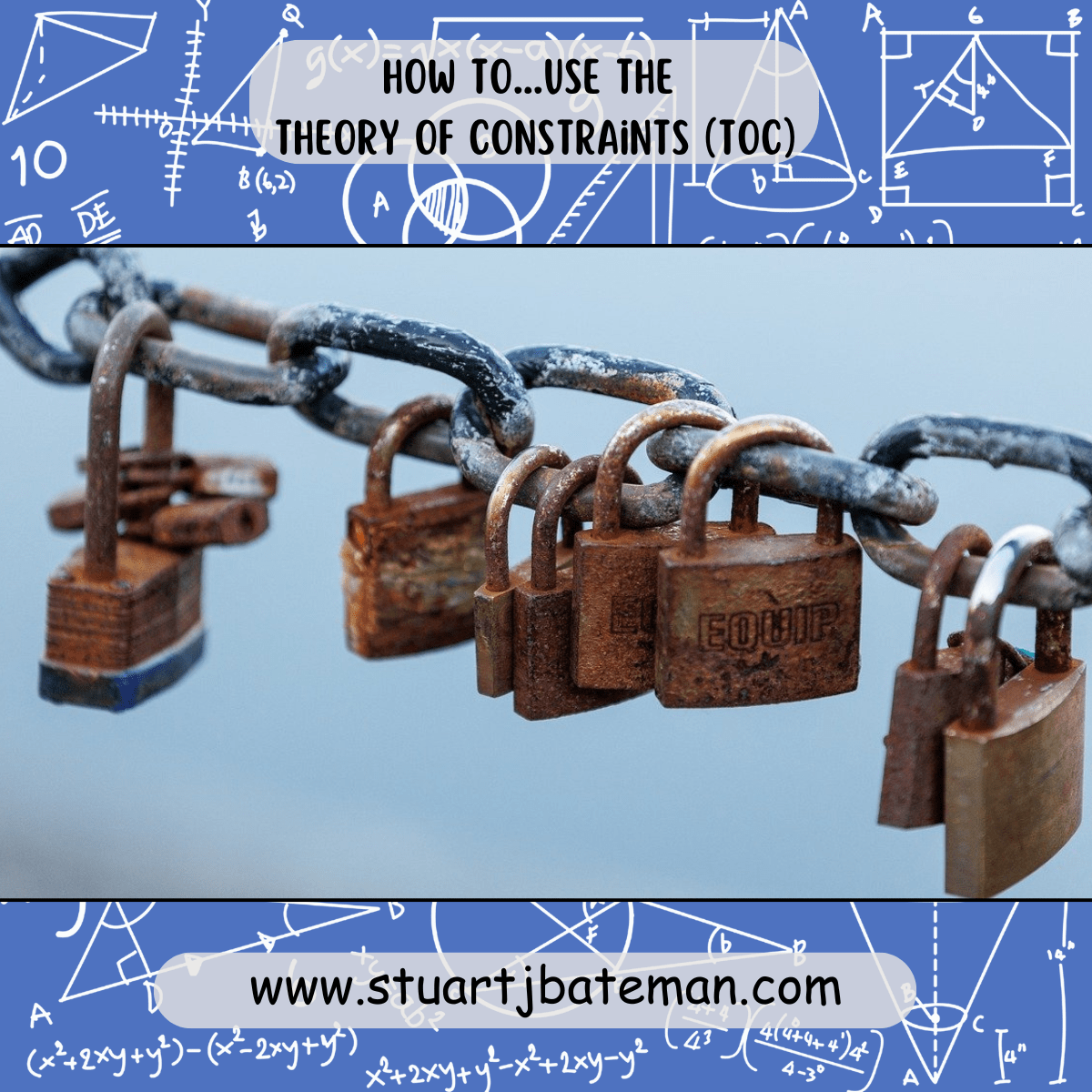
How to Use the Theory of Constraints
The Theory of Constraints (TOC) can be a great tool for helping you to find the best solution to a problem. This method of problem-solving is based on the principle of removing, or at least lessening, any obstacles that might be preventing you from reaching your maximum potential. In this blog post, we’ll explore how to use the theory of constraints to help you identify and resolve any challenges you are facing.
Eliyahu Goldratt wrote a great book called “The Goal” and even though it’s written like a novel it is easy to read, he presents his ideas in this story in a simple way for a reader to pick up on. The main character has difficulties at work with his factory and goes through a journey of what identifying a constraint is, along his travels he is helped by a professor who’s studied the theory of constraints at length and with this help, he and his team start to address the production throughput issues they have.
Now, there are 3 key ideas to this theory which we’ll address shortly, but I’ve used this idea start to finish in every process I’ve developed and improved, as you can take this theory and apply it anywhere in life from industry work to personal development. Once you are able to identify a constraint you can then start to think about how to deal with it, more importantly is knowing that once you’ve dealt with that constraint another will pop up, but for throughput you have to understand what your end goal is, if by dealing with 2 or 3 constraints you find that you can meet you demand, then stop. There are other tools within the Lean toolbox that can be applied to improve the flow. (SMED / TPM / 7QC)
What is the Theory of Constraints?

Like Line Balancing, the Theory of Constraint looks at the balance of the system or production line rather than just the individual stage. Every production line will have a series of steps with either a manual or automated interaction with the product, each one of those interactions will take an amount of time and depending on the process implemented, that step might process multiple of single parts at a time.
This give us a rate of throughput which depending on demand i.e. the Takt time, will highlight which process is a constraint or bottleneck or even both.
So what is the difference between a bottleneck and a constraint?
This has a lot to do with the demand, a bottleneck can keep up with demand but every product you have has to go through it (i.e. like an oven) whereas a constraint doesn’t have to be a bottleneck, it just can’t keep up with the demand or rather it can’t keep up to the Takt time. There are times if demand is high that your bottleneck also becomes the constraint.
With the understanding of these differences, we need to asses one production line at a time to identify constraints, once one has been found then we start the process highlighted below. What makes this a powerful tool in my opinion is like PDCA (or PDSA) we keep going after we have eliminated one constraint, we start to hunt for another and so this method itself becomes a continuous improvement cycle.
Here a great video I’ve used to help me implement this theory:
How is the Theory of Constraints Applied?
Now the process:
- Identify the Constraint
- Define the Goal – What production system needs improvements
- Walk the production system, Gemba again – it’s always starts with Gemba
- Record the data from Output / inventory and operational costs for the processes within the production system
- As the video talked about, use these measures to help identify the constraints in the chosen system
- Decide How to Exploit the Constraint (These are the 3 key ideas)
- Increase Capacity
- Double machines / stations
- Double shifts
- Reduce Demand
- Smooth demand by balancing over the weeks ahead if possible (capacity smoothing)
- Demand management, scheduling in the arrival of customers using advance reservations (this is an area I’m not familiar with so I’ll add a link for more information) www.mbaskool.com. And www.rowtonstraining.com
- Improve Efficiency
- Increase Capacity
- Subordinate Everything Else to the Above Decision
- Resources
- People
- Machines
- Investments
- Time
- Resources
- Elevate the Constraint
- Increase Capacity
- Add redundancy
Here’s a handy poster that I found:
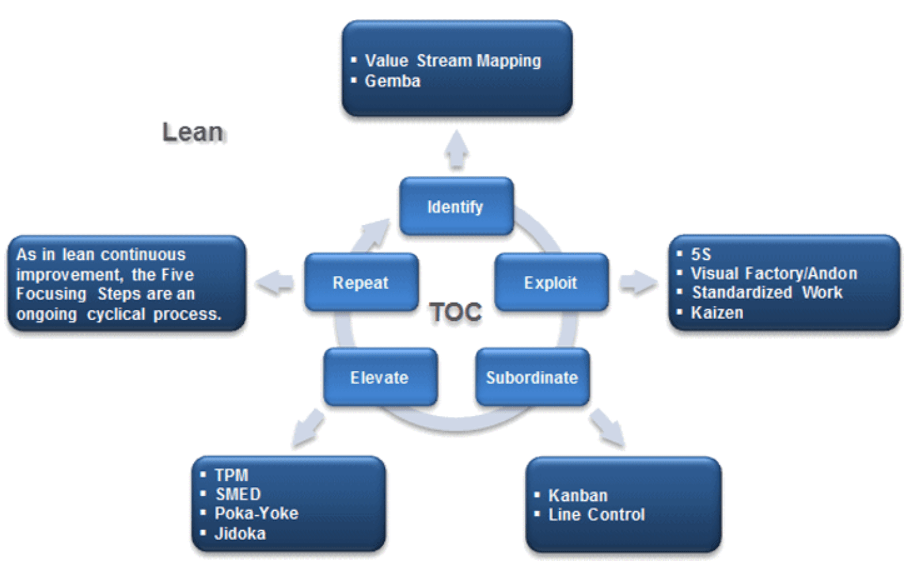
It’s important to note that any improvements you make in the production line will help flow, if you haven’t improved the constraint then the throughput doesn’t improve, as the throughput is governed by the constraint in the system and won’t go faster than that. It’s also important to note that if the constraint goes down the cost per hour lost is the entire production line cost, not just that machine (gives you more leverage when it comes to justifying costs to improve with).
Identifying the Constraints
This isn’t a difficult task to identify the constraints once you know the different between a constraint and a bottleneck, what I tend to do is two things, first I walk on the shopfloor looking at the WIP and seeing where it is and how it’s flowing – what I’m looking for here is where the work is building up as this will give me an idea where bottlenecks are. The next step is to time study the production line and analyse the takt times to see which process won’t meet the demand from the customer.
Having these two pieces of information you can look at those bottlenecks to see if they are constraints or not, it’s worthwhile here having your value stream map next to you to see the flow of each product and what the stages work on. Look to see if the bottleneck or constraint purely deals with runners and repeaters or is there the odd stranger job that pops up occasionally, if so you will need to deal with that first.
Next is priority if you see more than one constraint then the rule of thumb I go with is to start upstream (the start) of the production line and work towards the end where the product leaves the line, why? Because starting upstream and improving the stages will increase the throughput and cause the next constraint to show itself more clearly (without the need for further studies) then as you finish traveling along the line, you can then do the studies again to see how the production line as a whole has improved, this will give you a efficiently measure to benchmark against. If issues from the line comes up again you can remeasure and compare against the benchmark to see what’s gone wrong.
How have I dealt with Constraints?
In most cases if I’m talking about machine shops, I’ve added to the capacity of the constraint either by a second shift or additional machines (both new and second hand) and I’ve changed machine setups so that more than one can do a second process stage with no setup if another machine is struggling, this is in the form of jigs and fixtures that allow the additional setup ready if the machine / process needs to switch to it, for assembly it’s having additional fixtures and benches so that the task can be ‘doubled up’ depending if you have enough operator resources as well (also it adds in redundancy if breakdowns occur). In assembly I’ve either gone to eliminate the process or change the process to one that has a better cycle time, but again you can add staff or stations to increase the capacity.
There are occasions where the current processes can be sped up via new tooling and looking at the internal and external process steps (SMED again), here I use the WBS (work breakdown structure) to isolate between the two and measure them. After which I follow the SMED process to reduce the cycle times and move tasks around to reduce the effort the operator has to do when the cycle is running (as you might only have a small staff to run the production line with – another constraint in itself).
Rarely have I taken the route to sub work out and again that’s an operation managers job if I’ve presented them with the Capacity plan showing the load on the machines, usually this is done to give relief to the process right before you make the changes, this way you can test your solutions while production isn’t impacted as much.
Lastly there is the need to make sure that the constraint once identified, needs to be maintained so that it doesn’t break down (which causes the whole production line to stop and thus incurring the cost of the whole line), so I’ve carried out TPM on constraints to make sure spares and regular maintenance with operators checking the resource daily are being done.
Making Decisions Using the Theory of Constraints
Once you’ve done this process a few times, it becomes easier to ‘see’ a constraint based on production output (if you measure the hourly output). Decisions tend to be around building a new line and choosing the machines including the processes to go in, adjusting the layout of line or the factory around constraints or as above what can be done to break that constraint. Remember constraints don’t just exist on the factory floor they also exist in the office / supermarket / doctors / airport – basically anywhere and being able to see them allows you to choose how to deal with them (or not).
However, let’s look at the flip side to what a constraint is.. A machine / process or step that cannot meet customer demand, is the demand correct? Viable? Needs to be checked? Is the time study correct? Up to date? Is the process running to the SOP? Is the SOP correct? What’s the uptime of the process? Breakdowns? Changeovers? What’s the quality output? Many defects not being resolved? High scrap rate? Is this a complex process that needs to be broken down into sub steps?
Think about the OEE and the 6 big losses to generate the questions you need to ask to understand why the process step can’t meet the takt time, you may find out that the process is capable but the support structure or the care of the process or the defects aren’t being looked at and resolved.
For me these are the questions I would be asking first, also they are the types of metrics (especially OEE) that I would be measuring and resolving to ensure that when a constraint is found, these basic questions have been dealt with or at least managed for us to be able to ask further questions directed at the process. (Check out the 9 best Metrics to monitor)
- How long has this been a constraint?
- What aspect of the product does the constraint help produce?
- Can the design be modified / eliminated or adjusted to aid the constraint?
- How complex it the process? Can it be broken into smaller stages?
- Questions around the design of the process and product need to be asked, as these could be both quicker to resolve / implement and more cost effective than bringing in more machines and shifts to deal with demand (however, that may still be required as a temporary solution while these items are looked at and implemented)
Conclusion
The Theory of Constraints can be an invaluable tool for identifying and removing obstacles that are preventing you from reaching your maximum potential in throughput. With it, you can find the best solution to a problem or challenge and identify the constraints that need to be addressed. By applying the steps outlined in this post, you can use the Theory of Constraints to help yourself and your organization reach the goals that you set out to achieve.
Now that you know how to use the Theory of Constraints to find the best solution to any challenge, start applying it to your own work! Do you have any examples of how you’ve used the Theory of Constraints to help you meet your goals? Let us know in the comments below!
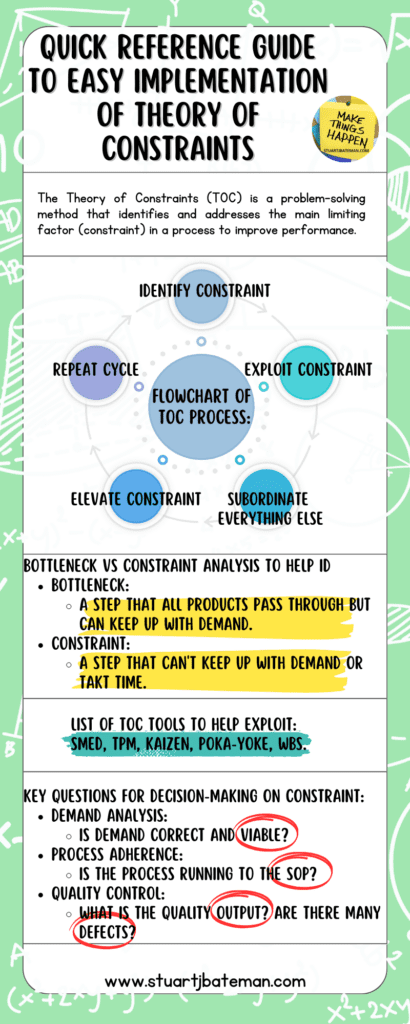
References
- The Lean Toolbox – Bicheno & Holweg
- The Lean six sigma pocket toolbox – George, Rowlands, Price & Maxey
- Lean six sigma 36 hour course – Shaffie and Shahbazi
- Lean Thinking – Womack and Jones
- The Toyota Way fieldbook – Liker and Meir
- Lean Smarts
- ISIXSIGMA.COM
- The Goal – Eliyahu Goldratt
- TPM the western way – Peter Willmott
- Lean Solutions – Womack and Jones

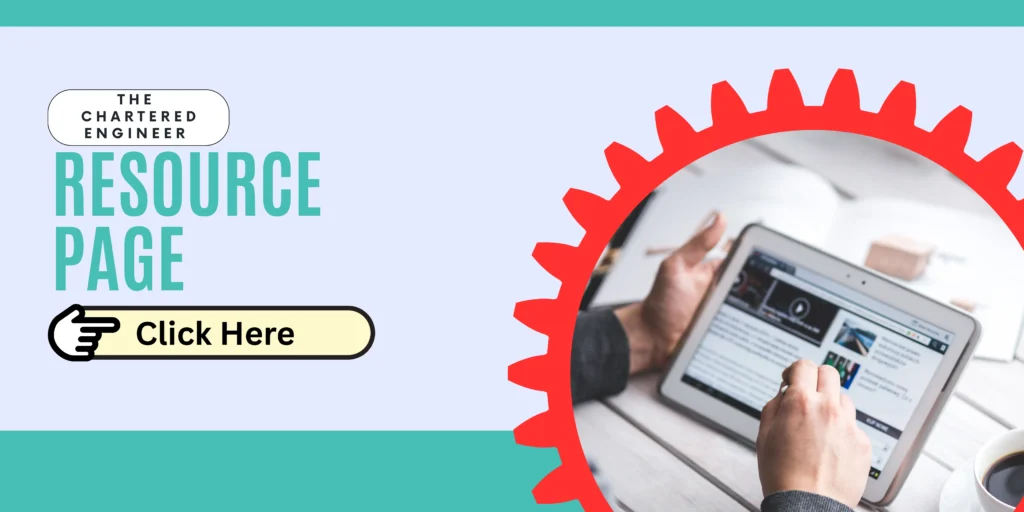
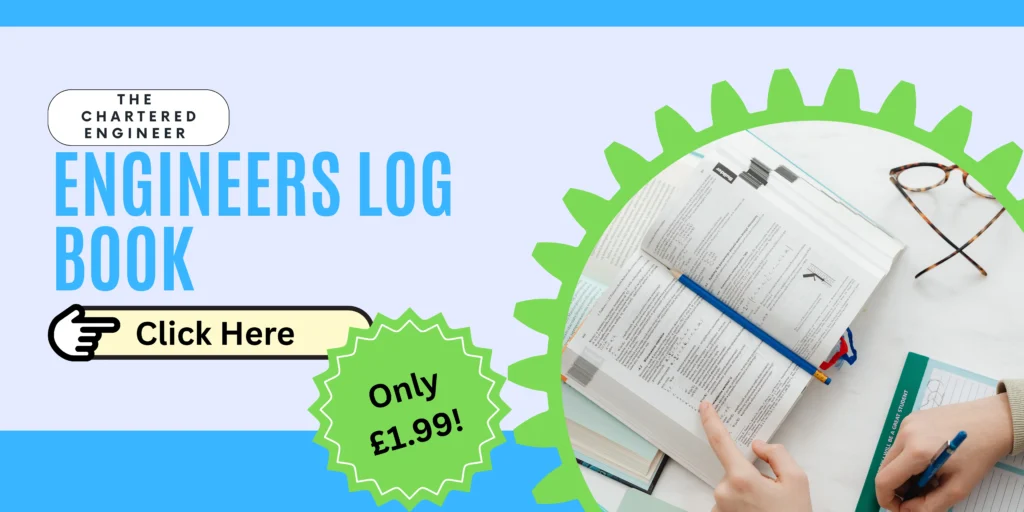
What are your thoughts? Have I covered everything or is there more you know and would like to share?
I’m always learning and improving this site and my blogs, so please feel free to get in touch with me via LinkedIn or this site to discuss any topics I have covered.
If you’re having trouble finding ways to progress check out these sites filled with free learning tools:


Discover more from The Chartered Engineer
Subscribe to get the latest posts sent to your email.